Next you will learn:
- What is a tooth cyst and why, in fact, it needs to be removed;
- What can happen if the cyst on the root of the tooth is not cured in time (or if it is not removed) and is it dangerous for neighboring teeth?
- What are the options for therapeutic treatment of cysts (that is, conservative, without surgery) and how effective are these techniques in the long run;
- Should I hope for the use of depophoresis or a laser in the treatment of tooth cysts;
- How is a tooth root apex resected with a cyst (in stages), how much does this operation cost today and is it a 100% guarantee of complete disposal of the root cyst;
- In what cases are teeth with a cyst most often removed from sin away, even without treatment attempts, and how this procedure is performed;
- Can a cyst remain after tooth extraction or suddenly form in the hole and what this threatens for the future;
- What very unpleasant complications can happen when a tooth with a cyst is removed and what recommendations in the postoperative period can minimize undesirable consequences ...
Today, even those who do not have a medical education are usually well aware that, under certain conditions, cysts may appear in the human body, which pose a considerable danger to health in general. So, with regard to teeth, this problem is especially relevant - on any tooth, whether it is a front tooth, a wisdom tooth or any other, for a number of reasons, the so-called root cyst can form. Moreover, several such cysts can occur on one tooth at once.
What is a tooth cyst? The root cyst of the tooth is a neoplasm localized mainly at the apex of the root and is a kind of capsule, the inside of the shell of which contains liquid. Under certain pathological conditions, the cyst is able to grow over time, increasing in size.
The photo below shows an example of a removed tooth with cysts on the roots:
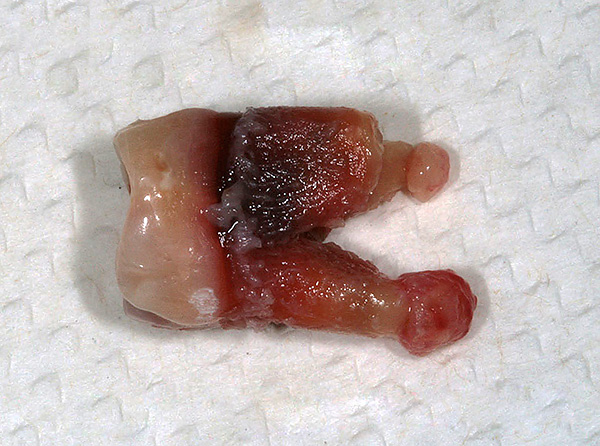
In many cases, it is important to remove the tooth cyst in time to avoid the development of serious complications. Here you need to understand that the formation of a cyst is a peculiar manifestation of the protective reaction of the body, which is trying to isolate the infection that has penetrated through the root canal of the tooth into the surrounding tissues. First, an inflammatory process occurs on the root of the tooth, which often passes into the cyst.
It would seem that there is something to worry about - a cyst has formed, the infection is reliably isolated. However, the problem is that such isolation of infection from healthy tissues is not eternal: a carious or poorly treated tooth in the canals continues to constantly nourish the tumor with bacteria, which creates a certain burden on the immune system. And at some point in time, for example, after hypothermia, the body’s immune system is no longer able to restrain the onset of infection, and when this “delayed-action mine” (that is, a cyst) breaks through, then we can talk about very serious consequences, including life-threatening (e.g., blood poisoning, phlegmon).
That is why it is important to remove a tooth cyst in time, or to cure it.
About what can happen if you leave a tooth with a cyst, is it possible to save it without surgery (without cutting the gum with a scalpel) and what are the methods for saving teeth with cysts today - about all this, as well as about some other interesting points, we go further and let's talk more ...
What will happen if the cyst on the root of the tooth is not cured in time?
As noted above, the main causes of tooth cyst formation are:
- Complications of caries (periodontitis);
- As well as unprofessional treatment of canals, turning into periodontitis.
In the process of its development, the tooth cyst passes through 2 stages of periodontitis, at which a rarefaction of the bone tissue of the jaw near the apex of the root with fuzzy borders occurs, and only then, due to the intensive decay of healthy tissues, a granuloma, cystogranuloma and (or) a cyst having clear boundaries are formed.
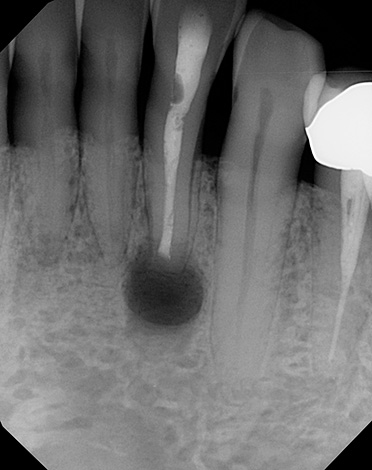
No dentist can tell in advance exactly when the development of the cyst will reach such a climax that the body will no longer be able to localize the infection in the formed capsule. With an exacerbation of the chronic process, purulent exudate spreads far beyond the borders of the cyst, often leading to very dangerous complications.
Listed below are just some of the possible consequences of continuous growth and "rupture" of the cyst:
- Purulent-inflammatory diseases of the maxillofacial region (periostitis, osteomyelitis, abscess, phlegmon, sepsis);
- Odontogenic sinusitis;
- Germination of cyst tissue in the maxillary sinus;
- “Thinning” of the jawbone (up to a possible fracture of the jaw while chewing solid food);
- Capture the roots of healthy teeth with a cyst.
The photo below shows an example of a huge cyst, which was not removed in a timely manner and, having increased in volume, has grown to the roots of an adjacent tooth:
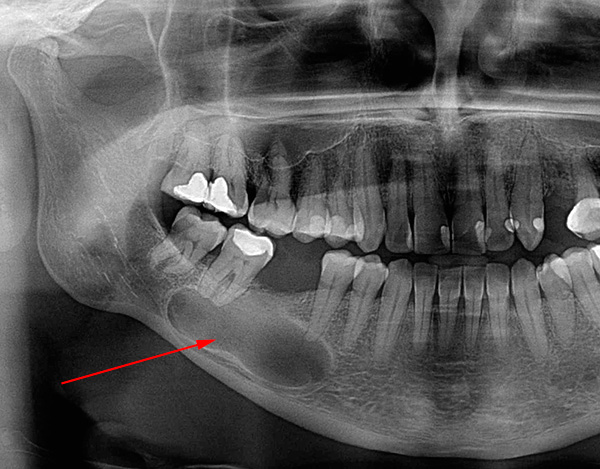
Comment by a practicing dentist
In fact, a cyst is a delayed-action mine, a kind of purulent pouch that can flop so that in the best case the face becomes twice as wide, and in the worst case, the entire infection will rush along the maxillofacial region to the neck and pose a threat to normal breathing, until it stops, or death occurs due to intoxication of the body due to the hematogenous (through blood) spread of bacteria throughout the body.
When a tooth with a cyst is located on the upper jaw, purulent processes leading to a life threat occur much less frequently than in the case of the lower jaw. However, due to the proximity of the maxillary sinus to the top of a diseased tooth in the upper jaw, sinusitis that cannot be cured by classical methods may develop as a complication. That is, an inexperienced ENT doctor can prescribe cuckoo sessions for an infinitely long time to relieve maxillary sinuses from pus, antibiotics and other drugs, but success will be achieved only for a short time, since the infectious focus at the root of the tooth will continue to nourish the inflammatory process .
Today, more and more often you can hear that there is a definite connection between the presence of a cyst on the tooth and the development of cardiovascular diseases. How is the situation really?
About 10-15 years ago, information about the effect of apical infectious foci on the development of cardiovascular diseases was attributed more to theoretical speculation than to real facts. However, today the medical community listens to the data of a mass study of 508 people with an average age of 62 years suffering from various kinds of heart diseases. Acute coronary syndrome was noted in the group with multiple infectious foci on the roots of the teeth, and a small percentage of individuals with single foci had unexpressed coronary artery disease. More than half of the “cores" (about 60%) had at least one inflammatory process at the root of the tooth.
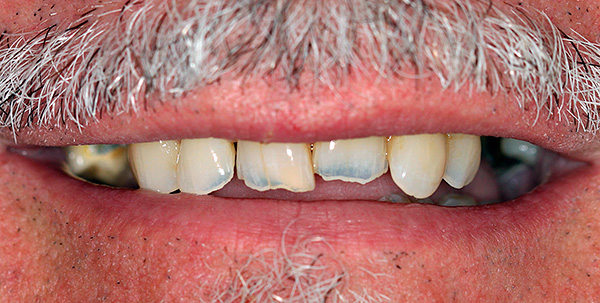
Of course, from the evidence point of view, the study is not ideal, since the presence of cardiovascular diseases is also affected by such aspects as obesity, smoking, diabetes, etc. Therefore, today experts consider the presence of root cysts on the teeth only as another risk factor for heart and vascular health.
Therapeutic (conservative) treatment of cysts
Based on the fact that a cyst can carry so many risks to human health, immediately after its detection (usually from a picture), a completely logical question arises about the need to remove it. Often, a tooth is removed along with a cyst on the root.
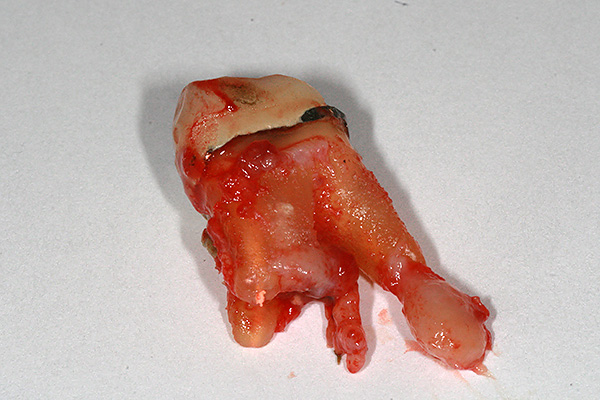
But is there really no way that allows not only to do without tooth extraction with a cyst, but also in general - without any surgical intervention associated, for example, with excision of a cyst? Maybe it can somehow be cured conservatively?
Before considering modern methods of “removal” of a cyst without surgical intervention, let's first get acquainted with some features of neoplasms that may be present on the tops of tooth roots:
- Granuloma is an overgrown granulation tissue in the region of the apex of the root of the tooth, which appears in response to radical inflammation. It is believed that granuloma is the initial stage of a cyst, and that, gradually increasing, granuloma sooner or later becomes a full-fledged cyst. In practice, sometimes there are large (up to 10-12 mm in diameter) granulomas, although the images of the tooth root stubbornly show a cyst;
- Cystogranuloma is a transitional stage between a granuloma and a cyst. It differs from the previous formation in some tissue features (although at the moment, not all experts believe that cystogranulomas should be distinguished as a separate type of neoplasm);
- And finally, a cyst - in its structure, it looks like an egg, which contains a certain amount of fluid (pus) under the shell.
Generally speaking, not so important, a granuloma or cyst formed on the roots of a tooth. A cyst differs from a granuloma, primarily from the point of view of histology, but in the practice of a dentist there is no fundamental difference between these forms to obtain a positive treatment result: the treatment is carried out by the same methods without taking a tissue for biopsy.
On a note
It is difficult to determine with an aiming picture and even with a CT scan with 100% accuracy what form of the inflammatory process is present on the root (s) of the tooth. Usually visible area of enlightenment with clear contours, usually rounded or oval. This "circle" can be located not only at one root, but also capture 2-3 roots of one tooth and even pass in the immediate vicinity of the tops of the roots of adjacent teeth, hinting to the dentist about the scale of the tragedy.
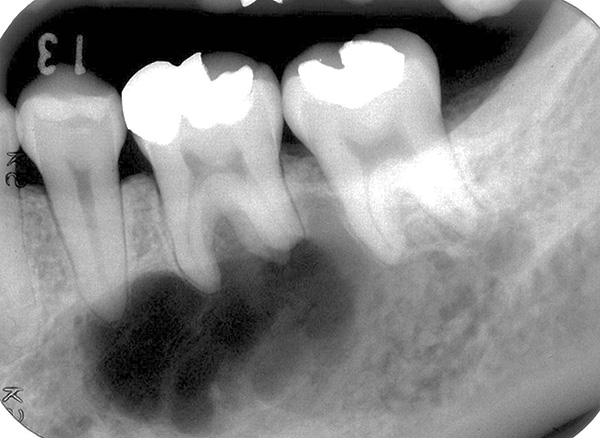
The key point that arises in practice is the decision: is it worth it to begin treatment of the cyst, or should you resort to removing part of the root of the tooth, or to remove the tooth completely with the cyst?
The final decision is influenced by the following factors:
- There are protocols that govern the ability to preserve a tooth;
- The qualifications and experience of the dentist greatly affect the final decision (an inexperienced doctor may not have other options but to simply remove the problem tooth from sin away);
- A high level of clinic equipment creates the prerequisites for the possibility of conservative treatment of cysts while preserving the tooth.
As for the protocols that doctors are guided by, it should be understood that the documentation does not keep up with technical progress in many respects, and the formulations (pastes) developed today, which are put into the canal to “remove” the cyst, often allow success even with huge granulomas and cysts.
In addition, in recent years, cases of conservative treatment of large-volume root cysts without the use of classical pastes based on calcium hydroxide have been increasingly described. There is an opinion that it is enough to qualitatively process the system of tooth canals using sodium hypochlorite and ultrasound, after which, thanks to sterile channels, the cyst simply ceases to be necessary for the body and disappears within 4-15 months.
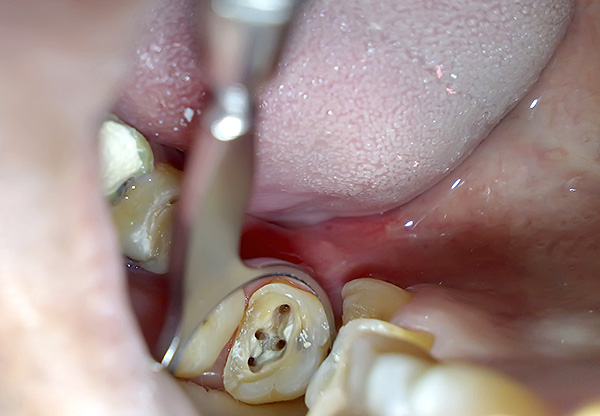
Conservative treatment of a tooth cyst (that is, its "removal" without surgery) is a lengthy process, but today it does not necessarily look like a routine. A routine treatment option for cysts is to visit a doctor almost every day to inject new portions of calcium hydroxide into the channels.
When using modern techniques, the patient, after a single visit to the doctor, walks with sealed canals and temporary restoration, periodically visiting the dentist to analyze the current state of the cyst from a tooth picture. The frequency of visits is chosen by the doctor, but usually the appointment is made after 2 weeks, a month, 3 months, 6 months, a year and two years.
A short summary: an experienced doctor with the appropriate equipment can very well save a tooth from extraction, even with a large cyst. However, it should be borne in mind that there can also be failures - sometimes after numerous attempts of useless treatment, the tooth is simply removed together with the cyst.
The use of depophoresis and a laser to remove a tooth cyst
One of the modern methods of removing the root cyst with the preservation of the tooth is the use of depophoresis, as well as a laser. Let's see if these methods really allow you to "destroy" the cyst at the top of the tooth root once and for all.
The use of depophoresis in dentistry has its roots in Germany, but in Russia it began to be actively exploited since about 1990. During this time, the technique gathered around itself both fans and opponents, who even claimed that depophoresis for endodontic treatment was categorically unacceptable.
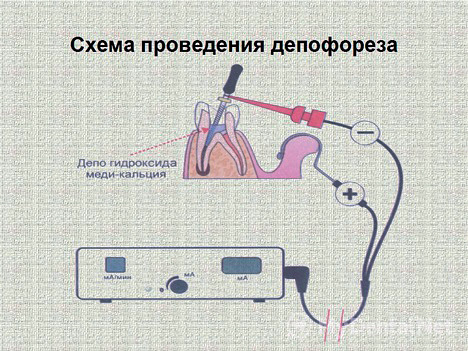
On a note
The meaning of depophoresis is to inject molecules and ions of strong anti-inflammatory and bone tissue regenerating drugs under the influence of electric current. In the case of treatment of a tooth cyst, one electrode is connected to the transitional fold of the oral cavity, and the other is placed in the channel together with copper-calcium hydroxide. Treatment involves three visits: in the last, alkaline atatsamit cement is injected into the channel (s) to the upper third.
One of the areas of application of depophoresis has been the treatment of inflammatory processes at the tips of the roots of teeth with periodontitis (including radicular cysts). In fact, depophoresis with copper-calcium hydroxide is a kind of symbiosis of drug treatment and filling of channels. And this is a kind of dream of any bad dentist: you don’t need to develop the entire canal, go along the most unpredictable curvature, fight against the impenetrable channels of the resorcinol-formalin tooth, do not necessarily try to introduce anti-inflammatory material as close to the apex as possible, and you can even accidentally break the tip of the instrument or make perforation - depophoresis, according to the authors, "will write everything off."
Thanks to this technique, the restoration of bone tissue in the focus of inflammation is slow, but true. According to some authors, the likelihood of success of such treatment is about 90-95% with a duration of an average of 10 to 12 months.
At the same time, many experts are inclined to believe that depophoresis with copper-calcium hydroxide should be used only as the last option, when other conservative methods for removing tooth cysts are not useful. In general, depophoresis today is not a common technique, even with the positive treatment results described in the literature.
Unlike depophoresis, the use of a laser to remove a cyst flashes much more often in dental offers. However, how justified is its use?
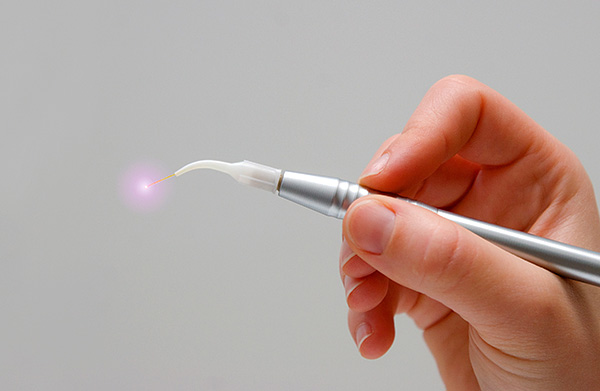
Speaking about laser treatment of cysts, we have in mind two areas of its use, namely:
- Additional antiseptic laser treatment of channels (sterilization);
- As well as transcanal laser dialysis.
As for the first direction: laser sterilization of the tooth canals has the same purpose as with the ultrasonic treatment of canals with sodium hypochlorite.A number of experts consider the use of a laser for such channel processing not entirely justified, since a laser, unlike the technique for sounding a channel with hypochlorite, cannot remove organics as effectively. The laser can bring much more benefit in surgical methods of cyst removal, which will be discussed below.
As for transcanal laser dialysis, this technique involves the introduction of a laser fiber into the dental canals, under the radiation of which, according to the advertising materials of the clinics, microbes die (literally evaporate) and the cyst cavity becomes sterile. Unfortunately, the use of a laser in the treatment of cysts is more of an advertising ploy than a real necessity, since in addition to the laser, this method then necessarily uses all the same drugs to introduce into the cyst cavity, which are also used without using a laser.
But how fashionable and easier to justify the increased cost of the procedure - this is a laser ...
What is useful to know about some tooth-preserving operations
Above we talked about conservative (therapeutic) treatment of a tooth cyst, that is, when the dentist does not perform an operation and does not cut out the cyst, but only creates certain conditions for its resorption. Typically, such treatment lasts an average of 6-12 months, sometimes longer, but without surgery.
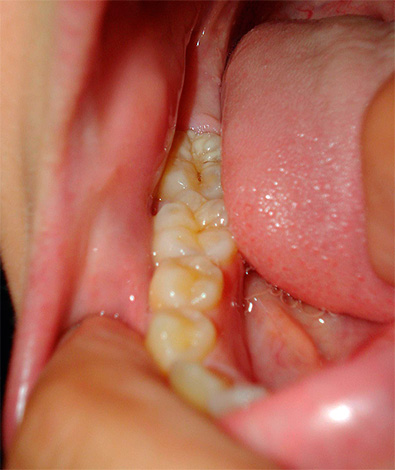
Removal of cysts in the literal sense of the word is carried out by surgical methods. Among them are:
- Root apex resection with cystectomy (cyst removal);
- Hemisection;
- Coronal Radicular Separation.
The last two tooth-preserving methods are not used so often in the practice of doctors, but the resection of the apex of the tooth root together with the cyst is of primary importance.
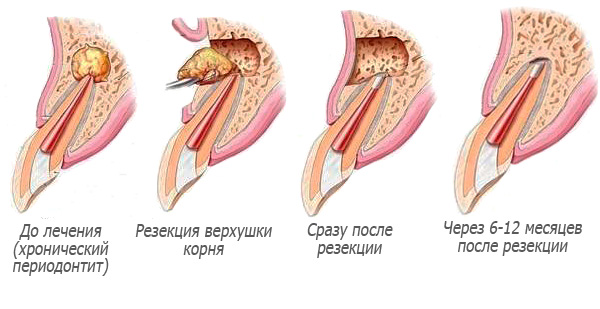
Usually this operation is carried out as follows:
- At the first stage, preliminary preparation is carried out, which may include consultation of dentists of various profiles (therapist, orthopedist, periodontist) - the question of the advisability of maintaining a tooth with a cyst is decided, and the patient’s health status is determined;
- The periodontist conducts professional oral hygiene (removal of tartar and plaque), the dentist-dentist fills the canals (with cement, gutta-percha or the Thermafil system);
- At the third stage, the dentist surgeon or maxillofacial surgeon starts the operation to remove the cyst. Anesthesia is carried out according to generally accepted rules - most often clinics work under local anesthesia when the person is conscious, but in certain clinical situations and according to indications they resort to anesthesia - introducing the patient into artificial sleep;
- After the operated area is anesthetized, the dental surgeon proceeds to cut the gums along the transitional fold in the projection of the apex of the tooth root affected by the cyst, and then with the help of a milling cutter creates access to the cyst (cuts out the “window” in the bone tissue);
- Then, the tip of the tooth root is cut off with a milling cutter (usually at an angle to see the quality of filling the canal with a therapist);
- After this, the contents of the cyst cavity are scraped out;

- After curettage, a cyst must be filled. For successful healing, xenografts or materials made from bone chips and blood of the patient are suitable;
- Suturing helps to reduce the clearance of the intervention area, rid the wound of infection and accelerate its healing with maximum comfort;
- At the end of the procedure, a comprehensive anti-inflammatory and antibacterial therapy is prescribed, as well as control examinations (pictures are taken once a month to track the dynamics of bone restoration in the area of removed tissue).
Professionals perform a tooth root resection with a cyst in about 20-30 minutes.This operation is today one of the most common and effective methods of preserving teeth whose roots are affected by a cyst (the cost of resection of a tooth root in clinics is today about 10,000 rubles.)
The success of the event directly depends on the ideally conducted each stage. If, for example, you do not completely remove the cyst, fill the area of the removed cyst with special materials, or do not carry out antibiotic therapy after surgery, then this can lead to a relapse of the infection process. In such cases, pretty soon the tooth is again at risk of extraction.
Feedback:
“Five years ago, when I fell, I hit my face so hard that both upper front teeth moved inward. I didn’t go to the doctor then, I just waited for them to stop reeling. I think that was my big mistake. After a couple of months, when the teeth were no longer staggering, a small pimple crawled out over the left, pus flowed out of it. I ran to the dentist, there was a cyst on the x-ray. At first they wanted to remove the tooth, but then they decided to perform an operation on the cyst and remove it. Before that, nerves were removed from the front teeth and glued to each other using splinting. After the operation, the doctor said to come and have a bone graft, as the cyst was large. But I never came, because I was very afraid that they would cut again. It's been 5 years, everything is fine with teeth ... "
Elena, St. Petersburg
In what cases are teeth with a cyst most often removed, and how is it realized
If a tooth with a cyst cannot be cured, it is assumed that it must be removed as soon as possible - it has already been said above how risky it is to continue to “grow” the cyst. Especially often, a tooth is removed in cases where an exacerbation has already occurred due to a cyst with swelling on the face, fever, difficulty opening the mouth, severe pain, etc.
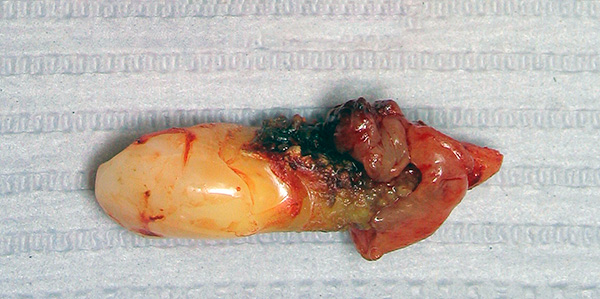
However, the final decision whether to remove the tooth with a cyst, or whether to try to carry out treatment, is taken by the dentist. In this case, the doctor is guided not only by officially existing testimonies (protocols), but also relies on his many years of experience, and often on the opinions of colleagues from related medical specialties. These are not only dentists of other profiles (dentists, orthopedists, surgeons, periodontists, orthodontists), but also neurologists, cardiologists, otorhinolaryngology, etc.
For a better understanding of the situations below are two typical examples.
A 78-year-old patient (male) with a history of history was brought to the dentist-therapist for the treatment of the front tooth with a cyst. Namely, the patient is registered with a local therapist for coronary heart disease, and a surgeon for disorders of the musculoskeletal system. Simply put, a person is not only hard to move around, but one can say in advance that he does not tolerate long-term treatment.
Is it worth it to remove a tooth with a cyst in this case, or is it better to prefer a conservative treatment option?
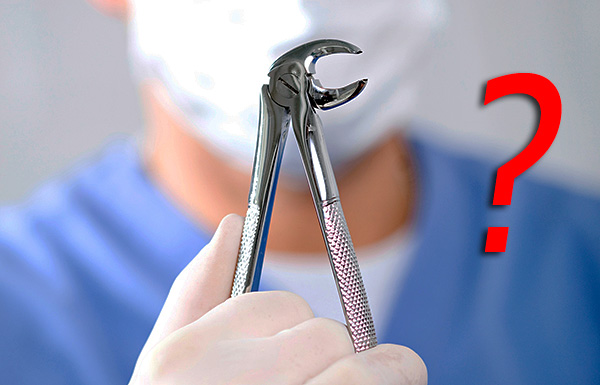
Formally, the cyst is small in size (2-3 mm), the front tooth is stationary, single-rooted, the root is even, but can a seriously ill person be able to undergo many months of canal therapy and frequent visits to the doctor? And how important is this tooth in the future for prosthetics? If you decide to remove a tooth with a cyst, how high is the risk of serious heart problems in a patient right in the doctor’s chair?
Today, there are many such patients at dentists, and each case is individual. As a result, the doctor himself often does not have any answers to all these questions, so common sense and the advice of colleagues come to the aid.
On a note
If a patient with a weak heart seeks emergency care (a tooth with a cyst exacerbated and leads to facial asymmetry), then the dentist-surgeon must carry out an urgent tooth extraction under the supervision of the attending physician (district physician, cardiologist, emergency team, etc. )Often the risk is so great that removal is performed in a hospital and constantly monitoring the vital functions of the body.
In the chronic course of periodontitis with a cyst, when the symptoms are not so bright, and there are no serious risks to life and health, the dentist must weigh the pros and cons, find out the opinions of colleagues and only then decide whether to treat or remove.
And now an example from another clinical situation, which is much more common (almost every other day). A patient, a 45-year-old man, came up with a large number of missing teeth, which is about to be replaced in the near future. There was no consultation with the orthopedist, but the patient decided to cure the lower right wisdom tooth with a cyst, as he is the last hope for a “bridge” as an end support.
Often people, turning to the dentist, with some kind of 6 feeling or special intuition assume the importance of a certain tooth for the future and in every way try to convince the doctor of the need to preserve the tooth. If the doctor is inexperienced, he will pay attention only to the tooth picture - and, for example, he will see only wide even channels, unbent roots and a small cyst (granuloma), as well as ease of access to the channels, as the patient can open his mouth wide. But the doctor can notice the 2-3 degree of tooth mobility only in the middle of treatment, when it is so hard to tell the patient: "You know, but the tooth turns out to be mobile." It’s the same as admitting your incompetence.
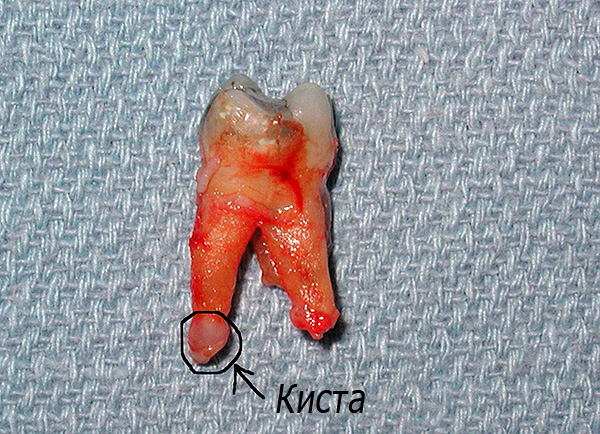
Therefore, it often happens that a young doctor successfully completes the treatment of a tooth with a cyst (in 2-4 months) and sends the patient for prosthetics, and the orthopedic dentist, checking the tooth for mobility, states the need for its removal and its absolute unsuitability as a support for the bridge. Due to the heavy load on the "bridge" in the coming months, the front support, which had previously been the most reliable, would have become mobile.
That is, the first doctor who did not check the tooth for mobility and did not consult with a colleague does not have clinical thinking, and one-sided decisions (by inexperience or “by piece of paper”) lead to the fact that treating a tooth with a cyst becomes a distant prospect, to say the least useless.
What else can stop a competent doctor from treating a tooth with a cyst:
- Serious orthodontic abnormalities (malocclusion);
- Poor patient hygiene;
- Significant loss of the crown of the tooth;
- Serious mistakes of previous doctors in the tooth canal (s) made during endodontic treatment;
- Preconditions for tooth overload when chewing food;
- Pathological abrasion of severe enamel;
- The large size of the cyst, when it creates serious risks for the roots of adjacent teeth;
- The patient's desire to definitely remove the tooth.
In general, it can be said that there are many cases where persistent long-term treatment of the cyst was unsuccessful and carried a train of disappointments for the patient (and the doctor).
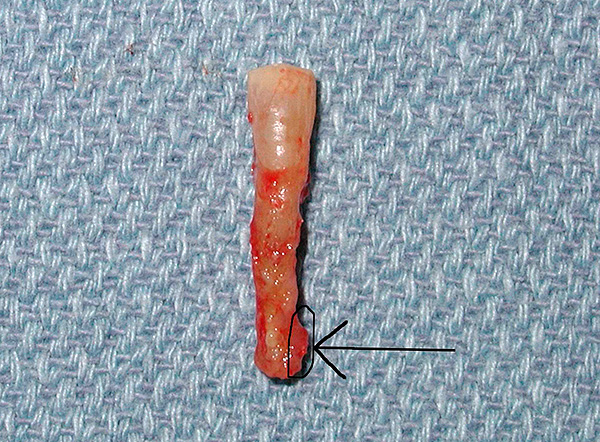
On a note
By the way, about the patient’s desire to remove the tooth at all costs. The dentist does not have the right to refuse the patient's request, but before that, a competent doctor, assessing the clinical situation, should give reasons for the possibility of treating the tooth, if any. For many reasons (including psychological and financial), the patient can not always afford long-term treatment of a tooth with a cyst, not to mention conservative surgery (resection of the apex of the root). Therefore, his request has the right to satisfaction after he signs the document - “Informed voluntary consent to medical intervention”.
Technically, tooth extraction with a cyst is almost no different from tooth extraction without a cyst. Most often, the procedure is carried out using forceps and elevators.
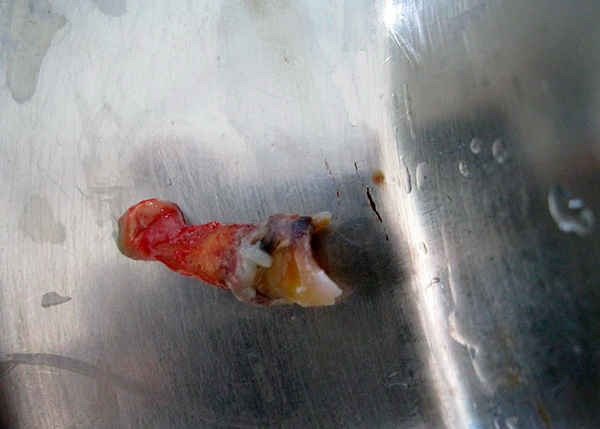
How is the cyst or granuloma removed?
When removing, the cyst is almost always evacuated along with the root of the tooth, but it also happens that it breaks away from the root apex, or even the apex of the root breaks off. When the cyst is removed, the dentist-surgeon scrapes the cavity with a curettage spoon or a trowel. In case of breaking the root, it can be removed with elevators, a curette spoon, or by cutting with a drill, followed by suturing of the wound.
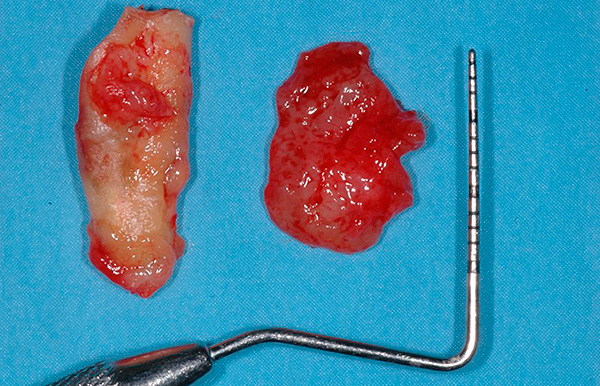
Is it possible to do without pain when removing a tooth with a cyst?
Before any surgical intervention, the dentist always performs anesthesia. The result of the work largely depends on its quality, since only in a calm environment can a tooth with a cyst be qualitatively removed - accurately and with minimal injury to the tissues surrounding the tooth root. That is why modern dentistry has a large arsenal of tools (anesthetics and components) that almost always allow any, even complex tooth extraction without pain in the patient.
Can a cyst after tooth extraction remain or form in the hole, and what does it threaten with?
Suppose that everything is left behind for the patient: the doctor safely removed the roots of the tooth with a cyst, stopped the bleeding and made recommendations. But did not check the quality of cyst removal!
Is it possible, in principle, to understand that all pathological tissue is scraped from the bottom of the hole and its walls, if the review is often closed due to increased bleeding? And what happens if part of the cyst remains in the hole?
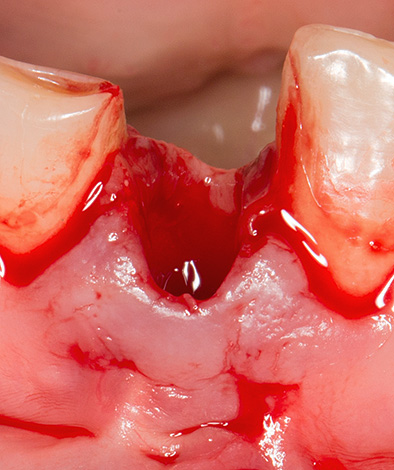
The cyst that the dentist left in the hole after tooth extraction is called residual. And this infection focus is not good for the future. The residual cyst can freeze for many years to “shoot” in the form of edema on the face (flux), abscess, phlegmon, sinusitis, or it will grow into the maxillary sinus, mandibular canal, etc. Or, from the very beginning, it will not allow the hole to heal normally in comfortable conditions - an alveolitis will arise, which will be extremely difficult to cure without eliminating the root cause.
It does not happen that a cyst by itself, "out of nothing" formed after a quality tooth extraction. If it formed, it means that not all the pathological tissue was removed from the socket, or the tip of the tooth root could break off during the extraction procedure. An abandoned cyst or granuloma has a tendency to overgrow and complications - this is worth remembering.
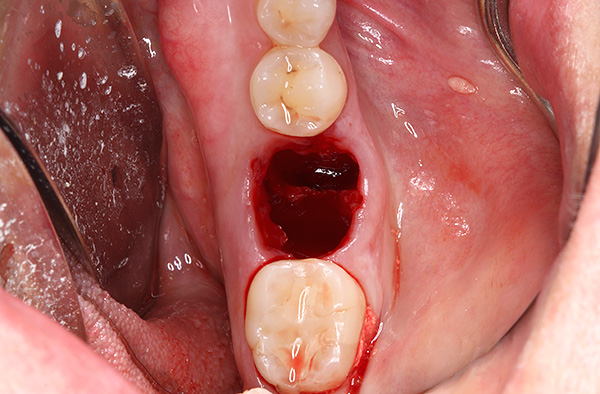
Feedback:
“I went to our hospital a couple of months ago, where they removed my back upper tooth, which had tormented me for a long time. Something cracked during the removal, but the doctor said that everything was fine. He gave me a list of medicines and quickly sent him home, since he had a full corridor for the people. On the second day, I realized that I was dying: my face was swollen, the temperature was 39, and the pain was no longer removed. I ran to this doctor, and he was almost at my doorstep: they say it happens, treat yourself with what you have so far. I spat and went to the private trader, and there they took a picture of me. In the picture, we found a piece of root with a cyst. A small shard, but with a huge cyst, as the new doctor said. He gave an injection and in 15 minutes removed this dirty trick. The pain completely disappeared, the temperature returned to normal and the swelling subsided. So in this case, the main thing is to find a good specialist and not really rely on butcher-dodgers in clinics ... "
Vitaly S., Stary Oskol
Possible complications and methods of their prevention
In some cases, after tooth extraction with a cyst, patients encounter situations that are incomprehensible to them (and very unpleasant), which sometimes cause almost panic. In particular, not a single dentist patient is completely immune from:
- Prolonged bleeding from the hole;
- Alveolitis;
- Perforation of the maxillary sinus;
- Jaw fracture (already at home, for example, with a meal);
- Paresthesia (persistent numbness of part of the face);
etc.
Fortunately, the last three complications after tooth extraction with a cyst are quite rare.
Perforation of the maxillary sinus sometimes occurs due to the proximity to it of the roots of the teeth of the upper jaw (mainly the upper 4, 5, 6 and 7 teeth) - for example, when the dentist surgeon is not very careful. In addition, germination of the cyst in the maxillary sinus is possible - in this case, after tooth extraction with the cyst, the message of the sinus and oral cavity appears.
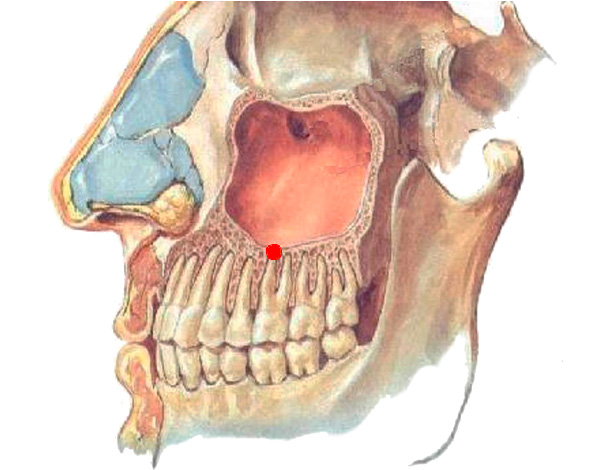
A dentist can test for maxillary sinus perforation after tooth extraction as follows:
- The patient pinches the nose and try to exhale through it. During sinus perforation, air is evacuated from it to the mouth;
- If you puff out your cheeks, then when perforating the maxillary sinus, air immediately enters the nasal cavity (this technique should be used only in extreme cases due to the risk of microflora being thrown into the sinus).
On a note
Sometimes, perforation occurs with the wrong tooth extraction technique: excessive pressure of the tool on its root or apex of the root, or directly on the bottom of the sinus.
Paresthesia of the facial areas (numbness) is characteristic of cases when a cyst grows in the mandibular canal, where the nerve passes. Less commonly, with excessive trauma of the intervention, when a nerve fiber is damaged directly by an instrument or is compressed by a hematoma.

Fracture of the jaw after tooth extraction can occur due to significant loss of bone tissue, when the cyst occupied a significant volume of the jaw (more than 1 cm in diameter).
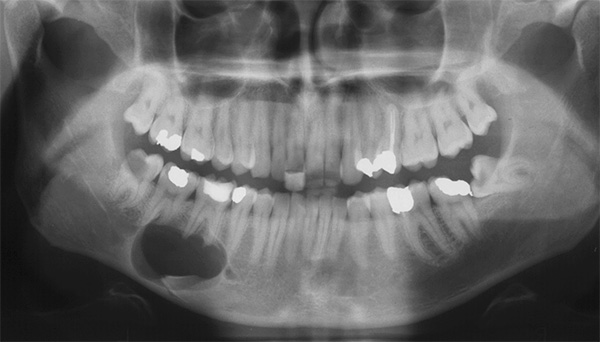
Prolonged bleeding from the hole and alveolitis are more common in practice than other complications.
The causes of unstoppable bleeding can be different: from damage to large vessels during tooth extraction to the patient taking medications that “dilute” the blood, or against the background of high blood pressure. The risk of deterioration of the general condition of the patient is possible with continuous loss of blood through the well for more than 6-12 hours. Therefore, in case of prolonged bleeding, there is no point in waiting for hours that the blood itself will stop - it is better to take timely measures.
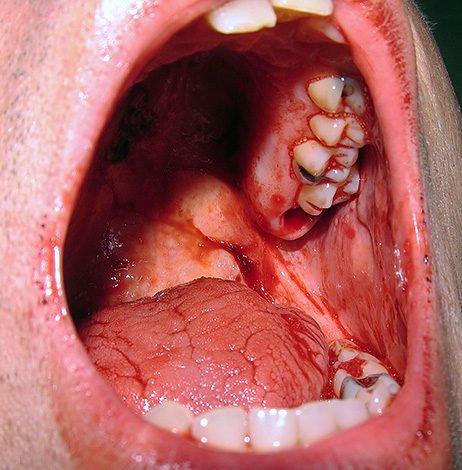
Before visiting a doctor should:
- Measure blood pressure and normalize it by taking the drugs prescribed by the therapist;
- Stop taking anticoagulant drugs;
- Put a sterile gauze ball on the hole and press it for 15-20 minutes. The main thing is the compression force (but without fanaticism), since the hemostatic effect depends on this factor;
- If the previous method is ineffective, you can drip a little 3% hydrogen peroxide on the middle of a sterile gauze ball and also tightly hold the swab between the hole and the opposite tooth (hydrogen peroxide has hemostatic properties);
- In extreme cases (if there is no way to get to the doctor at all), you can buy a hemostatic sponge in a pharmacy and put it on the hole or partially in the hole, also pressing on top for 10-15 minutes with a sterile gauze swab.
Alveolitis (inflammation of the hole after tooth extraction) may be the result of poor cleansing of the wound from the remnants of the cyst and fragments of the tooth. Often, the patient himself is to blame for the development of alveolitis - if the doctor's recommendations are not followed. The consequences of this improper behavior are different: severe pain in the hole, swelling, fever, putrid breath (and even more serious, up to osteomyelitis and abscess).
Key recommendations after tooth extraction with a cyst
Now let's see what to do after tooth extraction with a cyst so that the hole does not hurt and heals faster. If the dentist’s tactics when removing the tooth were correct, then the further prevention of complications depends only on the patient, to whom the doctor should issue a list of recommendations.
Unfortunately, it often happens that the dentist does not inform the patient about the actions after removing the tooth with a cyst (either forgets or simply does not want to spend time on this).This happens both in Moscow and in the regions - in private hospitals, where every day a dentist-surgeon, exhausted by “kilometer” bursts of patients, removes teeth in batches, and the price of the question can be ridiculous (200-300 rubles), or the service is generally free .
Below is a universal list of recommendations after tooth extraction (with and without cysts), it’s quite “running”, according to the positive reviews of medical specialists:

- 3 hours do not eat;
- Apply a cold compress to the area of removal from the cheek for 15-20 minutes every 2 hours, avoiding hypothermia;
- For 4 days, refrain from rough, spicy and hot food;
- Exclude heavy physical exertion, hot showers, baths, saunas, steam rooms, etc .;
- Do not disturb the wound (do not climb into it with your hand and toothpicks, protect from any irritants);
- Maintain an adequate level of oral hygiene (use a soft toothbrush, without neglecting to brush your teeth near the hole).
These tips are most adapted for most patients. However, even with these recommendations, there is no 100% guarantee that after removing a tooth with a cyst, the well will heal without problems.
The likelihood of problems when observing these recommendations will be minimized in the case of simple tooth extractions that are not in the acute stage. If the cyst was large, and pus literally oozes from the hole after tooth extraction, then we are talking about the need for the doctor to use an additional arsenal of drugs: antibiotics, antihistamines, painkillers and wounds.
Be that as it may, it is useful to listen to your body and be guided by common sense. And if, for example, the hole hurts for a long time, or incomprehensible sharp fragments stick out from it, it’s better to see the doctor once again, not being shy to disturb him.
An interesting video about the modern approach to the problem of tooth cysts
An example of removal of a cyst in the upper jaw followed by bone grafting and suturing

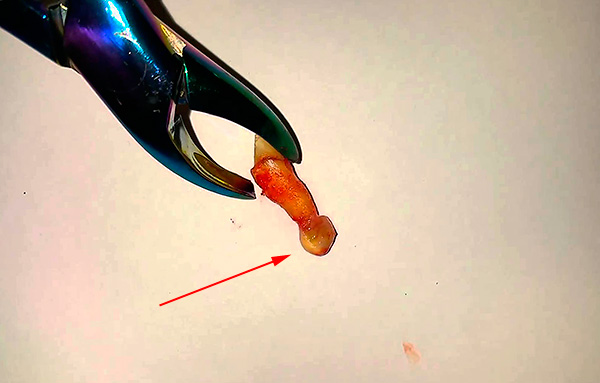
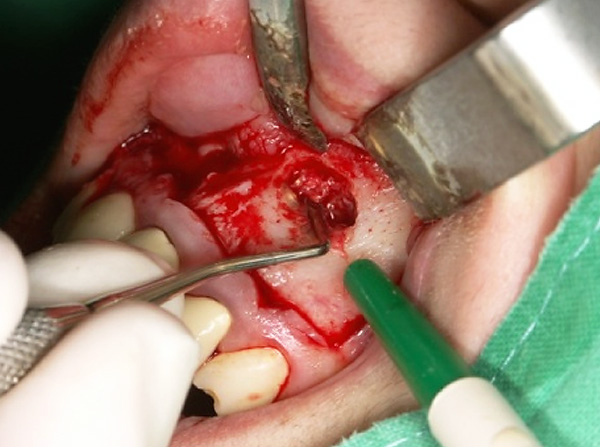
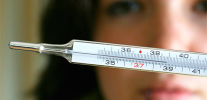
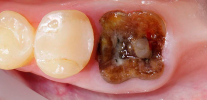
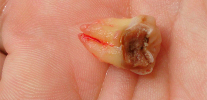
Hello, I'm pregnant, week 19. I was told that I have a tooth cyst. They said that they need to be removed. How is it done with anesthesia? I am afraid what will happen tomorrow. I hope I do not lose the child.
Hello! If we are talking about resection of the apex of the tooth, then most often it is performed under local anesthesia with an anesthetic safe for the fetus (the presence of contraindications is always taken into account). If we are talking about tooth extraction with a cyst, then more often this procedure is also performed under local anesthesia, without anesthesia (that is, we are not talking about tooth extraction “in a dream”).
In principle, the doctor does not have the right to begin any manipulation without obtaining your consent and determining the risk of an upcoming operation. So be sure to get a detailed consultation: what will happen and what drugs will be used.
Hello! The son is 17 years old. It is recommended to put braces. They took a panoramic picture and it turned out that there was a cyst on the bottom six. Faced with a dilemma: one doctor suggested that the cyst be removed surgically.Another doctor is categorically against this method, arguing that there is a high risk of paresis. Is it really so risky to have surgery? Thanks.
Hello! There are so many doctors, there are so many opinions, especially on difficult situations, but here it is not so simple. The proximity of the mandibular canal to the area of surgical intervention can indeed have certain risks of developing paresthesia (from 2-3 weeks to several months there is a feeling of numbness that does not pass after a visit to the dentist). Such problems in patients can be observed even after the work of a first-class specialist.
I will not undertake to comment on the opinions of those two doctors you are talking about, if only because I am not aware of the details of the clinical situation and there are no panoramic images. However, it’s quite obvious that now it’s useful to get more information for making a decision by contacting 1-2 more experienced specialists who may look at the problem from a different angle and maybe suggest not to remove the cyst, but try to cure it without deleting.
Thanks!
Good afternoon! Please tell me, after tooth extraction with a cyst, how long can purulent fluid with blood come out of the hole? And what measures should be taken if aching pains and swelling appear? The doctor said to take amoxicillin to help the body cope. Is everything right?
Hello. After tooth extraction, exudate may be excreted within 1-2 days. To improve the conditions of his departure, the dentist-surgeon often makes an incision in the area of the transitional fold, which is a mandatory measure for some purulent diseases of the tooth (with periostitis, for example). If there are aching pains and swelling, it is important to consult a doctor for an examination to rule out something serious.
The antibiotic prescribed for you is a completely adequate measure, which is necessary for purulent infection to exclude postoperative complications.
Hello, they removed the cyst, but the lump on the gum remained. Is this the way it should be?
Hello Denis. In the first 3-5 days after the operation, edema is possible (perhaps you call it a "bump"), then the edema should subside.
In addition, the lump may remain if the cyst membrane is not completely removed or the postoperative wound is inflamed. In this case, this is not normal, and if the cone persists, then the chances of self-healing are extremely small. It will require a second operation (revision of the cyst bed), or tooth extraction. Therefore, if the condition of the gums does not improve every day, then you need to see a doctor to clarify the situation and choose the tactics for further treatment.
A bump with pus is visible on the outside of the gum, and the picture was taken on the inside of the gum, the picture showed nothing. The doctor said that you need to wait a bit. And if it gets worse? How long should I wait and what should I do?
Hello Anna. No need to wait. It is possible that you have formed a so-called fistula with purulent discharge. This is a sign of the presence of a focus of infection. If the assumption is true, then this itself will not work - urgent endodontic treatment is necessary (that is, treatment of tooth canals). Otherwise, the situation may result in tooth loss. So I recommend going to another doctor (to get an additional independent opinion) and clarify the situation.
Good afternoon. Tell me, please, is it realistic to remove a cyst from the top three without removing the bridge? Two years ago, she did the implantation and really asked the doctor to remove all my roots (it’s the roots, since there were no tops anymore, the pins were inserted, and the crowns were on them).My body is prone to cysts. But the doctor decided to keep "my teeth." All, of course, healed. And they did very well, but two years after another hypothermia - again a cyst! I took a picture, and all 6 front upper teeth with granulomas. And on the two and three cyst. The bridge is of high quality. Is it possible to ruin everything ?!
Hello Irina! Yes, it is indeed possible to remove the cyst surgically without removing the bridge (by resection of the apex of the root). However, in order to remove a cyst, you must first evaluate its size and condition of adjacent teeth. For diagnosis, it is necessary to take an x-ray (CT), in which it will be possible to examine in detail each tooth and the cysts present. I recommend contacting an experienced dentist-surgeon for a consultation and assessment of the possibility of maintaining the corresponding teeth.
Hello. I have such a story: on the upper jaw there was a bridge of three units. The gum over the 26 tooth began to hurt, made an x-ray, the picture showed nothing. Appointed rinses. The situation worsened, sent to a surgeon. He looked, made an incision in the gum, put a drain, said that there are granulomas, it is necessary to remove. They did a CT scan, revealed on the root of the cyst.
We decided to remove, the tooth root with a cyst was in millimeters from the maxillary sinus, therefore, we went to the competent surgeon to the Institute of Dentistry to remove it. The bridge was removed, the tooth was removed. And the gum, meanwhile, did not stop hurting. They decided not to take a second shot and, after healing the holes, put a new bridge with support on nearby teeth.
Six months have passed - the gum over the extracted tooth again became very inflamed. Swollen, an abscess formed, pus flowed out. They cleaned the gums without removing the bridge, prescribed an antibiotic, rinsed with chlorhexidine (I must say that the last time the antibiotic course was also taken). After that, a hole the size of a match head formed on the outside of the gum. In this hole they put marleck soaked in a disinfectant solution. On the second day, gauze was pulled out of the gums. It hurts, like heals ... What should I do? How to stop this biennial epic? Please give practical advice, what should I do? Maybe you need to take a second CT scan? Maybe there was a cyst?
Hello Svetlana. Without infection, the tissues inside the gums would not become inflamed - hence, the infection was present. Perhaps, when removing a tooth with a cyst, defects were nevertheless made.
I recommend that you contact another 2-3 experienced surgeons for a consultation, and immediately. Most likely, you will need to re-take the picture (better immediately CT). Only after a good diagnosis can you find out the true cause of the persisting problem.
Hello! Tell me, please: my tooth was removed, the gum did not heal for a long time. I went to the doctor - it turned out that there was a cyst in the hole. They removed her, but after a week I felt that there was something else in the hole. And the hole does not overgrow. What to do?
Hello, Hope. After re-cleaning the hole, most likely it began to heal by second intention - this means that the healing will take a little longer, but also safe. Be that as it may, it is useful to monitor the process with the doctor, so I would recommend that you make an appointment with the doctor now to assess the situation.
Hello! The day before yesterday I removed a tooth due to a cyst, but the cyst remained inside! The doctor said that she herself should go out, but a white abscess appeared on top of me. And the hole is not red, but black. The doctor said just rinse with chlorhexidine. Is it possible that the cyst will come out on its own?
Hello! The cause of cyst formation is a bad tooth, after removal of which the cyst cavity usually overgrows with a healthy bone. However, it is important to understand well what exactly remains in the hole - if there was a fragment of the tooth root with a cyst at the end (this would be a much more unpleasant situation). Therefore, in case of doubt, I would recommend contacting a doctor (possibly another one, not the one that removed the tooth) and making control diagnostic pictures.
Good evening! Please tell me, I have a cyst on the 5th and 7th tooth of the lower jaw, the doctor is ready to remove both cysts in one operation. On the Internet they write that the cyst on the 7th is not removed surgically. How to be